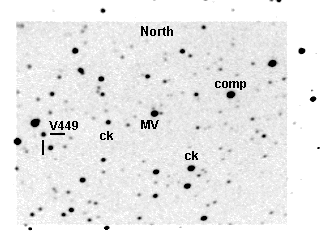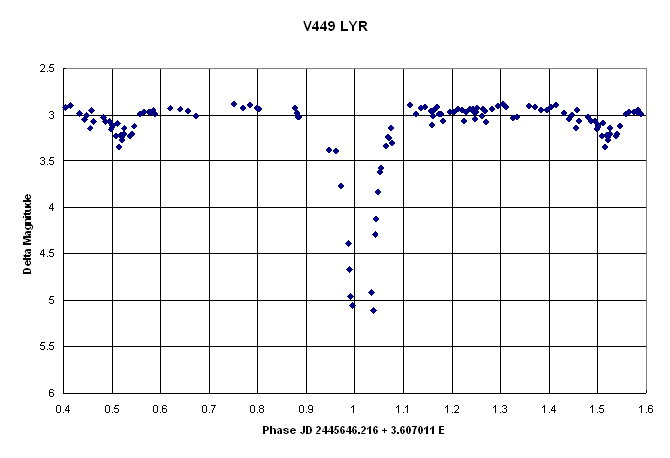 |
North is up on this stacked image of the MV Lyr field showing MV Lyr, its comparison star - also used for V449 Lyr, and two check stars. The one south of MV Lyr is the one which is suspected of being variable. The one to the East (right) of MV Lyr is the star indicated on some charts as being V449. It has shown no variation during the run on V449 Lyr. Stars down to magnitude ~19 are shown here. The image covers about 8.3 arc min in RA and about 6.7 in declination. |
Because of the presence of brighter stars very near the variable that could interfere with measurements, images for photometry were carefully selected. Those of poor quality (due to tracking errors, telescope vibration by the wind or airplane, satellite or meteor tracks across the portion of the frame containing the variable, or other effects) were eliminated from the photometry list. The photon statistics on the images are poor due to the fact that the images were all taken for only 16 seconds in order to monitor another nearby star, MV Lyr. That star varies rapidly and was a high priority target.
Jan Manek at Stefanik Observatory in Prague ( jmanek@mbox.vol.cz ) found the period and initial epoch of primary minimum used in calculating the phases shown in the light curve here. His work is being published separately. His light curve also shows a deep primary eclipse but no secondary eclipse. Here, there appears to be a 0.2 magnitude decrease in brightness around phase 0.5, and is probably the secondary eclipse. Manek's data was taken with blue sensitive photographic plates, while the data here is with a CB245 CCD camera, unfiltered, which is mostly red and near IR sensitive.
The data is averaged to reduce scatter inherent in the measurements of a star this faint on these images. The groups generally of 15 to 50 points were averaged, with images grouped for averaging based a short time interval (usually less than 30 minutes).
The brightnesses for the star were determined relative to the comparison star GSC 3132:01048, a 12.5 magnitude star. Although this is not the closest potentially acceptable comparison star to V449, it was used as a comparison star for measurements of MV Lyr and the check star suspected of variability.
When the variable was very faint in eclipse (approaching phase = 1), the data were extremely erratic due to photon counting statistics, and will be repeated by summing several images to obtain better counting statistics.

From two nights of observations about the secondary minimum, it appears to be slightly displaced, occurring at phase ~0.52. This was first considered to be either the result of there being period changes or of an elliptical orbit (the position of the primary eclipse had not been determined then). From data collected on October 3-4, 1999, it is apparent that the primary eclipse is displaced a similar amount, so the period is longer than the initial estimate of Manek.
Is the eclipse total? From the light curve, it is not clear. The photometry is not very good due to the faintness of the star (V~15.3 at brightest) at secondary eclipse and the lack of coverage at minimum of the primary eclipse.
This is a "work-in-progress". Most data from the nights observed so far have been measured. More data will be posted as it is available. A note will be written up for publication, probably in the Journal of the AAVSO.